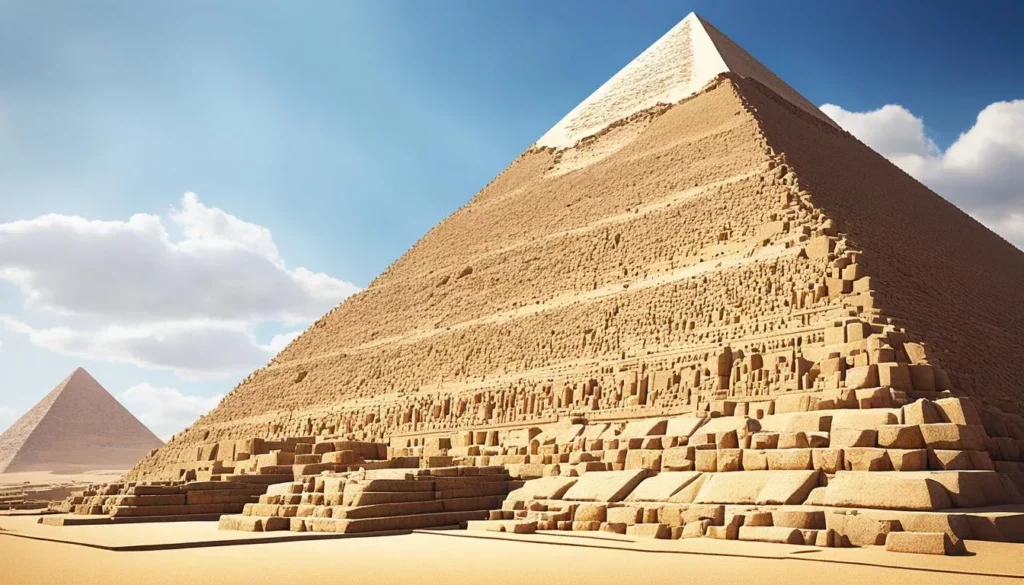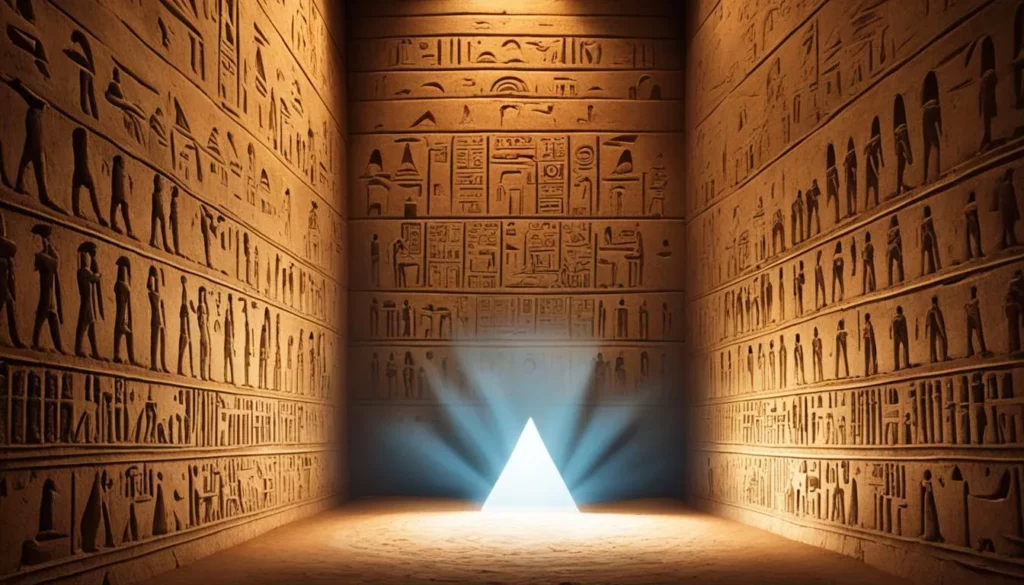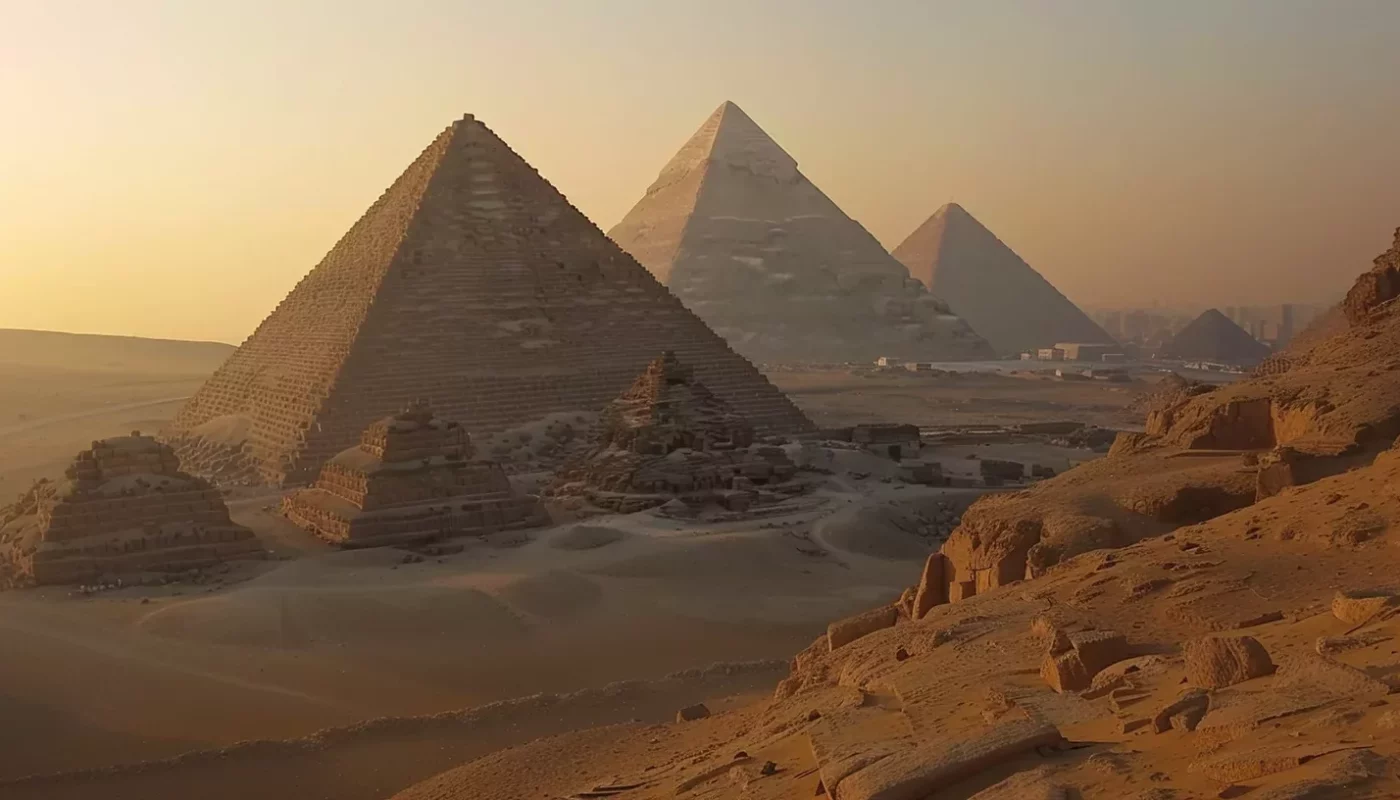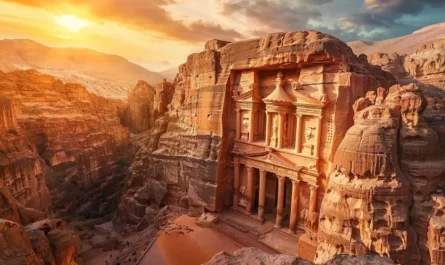Did you know the Great Pyramid of Khufu is as heavy as 16 Empire State Buildings? This fact shows the huge size and advanced engineering of the Pyramids of Giza. These wonders have amazed the world for over 4,500 years with their design and importance.
In the Giza Necropolis, Egypt’s famous pyramids stand as big signs of the ancient people’s cleverness and religious views. Visiting these wonders takes you back to a time tied to the pharaohs and their beliefs about the afterlife.
The pyramids amaze us with their big size and exactness, and the secrets they still keep. They remind us of our long struggle to understand life, death, and what’s beyond.
An Introduction to the Pyramids of Giza
The Pyramids of Giza are ancient wonders, standing tall for over 4,500 years. They showcase Egypt’s rich history and are a tribute to its architectural genius. These structures served as final resting spots for Pharaohs Khufu, Khafre, and Menkaure. They are key historical landmarks globally.
Historical Significance
These Egyptian pyramids are much more than ancient tombs. They reflect the ancient Egyptians’ beliefs and their advanced technology. Each pyramid at the Giza plateau tells us about the lifestyle and beliefs of times long past. They remind us of Egypt’s cultural depth and the enormous effort taken to build them.
Location and Accessibility
The Giza plateau, near Cairo, is a must-see spot. Cairo’s good transport makes it easy to visit. You can get there by taxi, bus, or metro from most parts of the city. It’s simple for anyone to visit and experience an important part of human history.
The Great Pyramid of Khufu
The Great Pyramid of Khufu is also called the Pyramid of Cheops. It’s a symbol of Ancient Egypt’s architectural skill. Originally, it was 481 feet tall. For over 3,800 years, it was the tallest structure made by humans. This shows the builders’ extraordinary skill.
Architectural Brilliance
The Great Pyramid’s design is genius. It closely aligns with the cardinal points and has a complex structure inside. This shows they knew a lot about geometry and astronomy. The inside has the King’s Chamber, the Queen’s Chamber, and the Grand Gallery. Each part shows great attention to detail and skill.
Construction Techniques
How the Great Pyramid of Khufu was built remains a big mystery. People have guessed they used large ramps or other smart solutions. It’s made of millions of limestone blocks, with some weighing up to 80 tons. Today, new experiments and tech like infrared thermography reveal more about these construction secrets.
Hidden Chambers
Not long ago, new hidden chambers in the Great Pyramid were discovered. Scientists used cosmic-ray scans to find these unknown spaces. These hidden rooms give us more clues and make us wonder about their purpose. These finds prove the skill of Khufu’s builders and keep us hooked on the Pyramid of Cheops.
The Pyramid of Khafre
The Pyramid of Khafre, also known as the Pyramid of Chephren, is an ancient marvel. Near the Great Sphinx of Giza, it shows off Egypt’s historic skill in building. Its outer casing is still there, letting us see what these old giants looked like when new.
Unique Features
This pyramid’s exterior is smoother and better kept than others. We can see the polished limestone that used to cover all pyramids. It shone in the sunlight, showing the power of the pharaohs. Its base is granite, and it stands tall at 136 meters, showing its importance.
The Great Sphinx
Next to the Pyramid of Khafre is the Great Sphinx of Giza. It’s a huge statue with a lion’s body and a pharaoh’s head, likely Khafre’s. It guards the pyramid and amazes those who see it. The Sphinx shows the power and wisdom of those times.
There’s a special temple in front of the Pyramid of Khafre. It was key in the burial rites of Ancient Egypt. Linked to the pyramid by a pathway, it was a place for rituals and gifts for the pharaoh’s journey after death. It helps us understand old Egyptian religious customs.
| Feature | Description |
|---|---|
| Pyramid Height | 136 meters |
| Nearby Monument | Great Sphinx of Giza |
| Mortuary Temple | Located at the base, connected by a causeway |
It’s crucial to keep the Pyramid of Khafre and nearby sites safe for the future. Work is being done to fight erosion and pollution. Protecting these sites lets us continue to learn from Egypt’s vast history.
The Pyramid of Menkaure
The Pyramid of Menkaure, known as the smallest pyramid of Giza, is a marvel of ancient engineering. It showcases the ancient Egyptians’ advanced construction techniques.
Even though it’s not as large as Khufu’s or Khafre’s pyramids, the Pyramid of Menkaure has its special allure. Every stone in this amazing structure tells a story. It shows the incredible skill of the builders who made these pharaonic tombs about 4,500 years ago.

When you see the smallest pyramid of Giza, you’re struck by its detailed architecture. It stands out from the bigger pyramids. The way it was built shows the ancient Egyptians’ advanced skills.
To understand how it compares to the other main pyramids, let’s look at some details:
| Pyramid | Height | Base Area | Notable Features |
|---|---|---|---|
| Great Pyramid of Khufu | 481 feet | 13 acres | Largest pyramid, complex internal chambers |
| Pyramid of Khafre | 471 feet | 11 acres | Distinctive capstone, close to the Great Sphinx |
| Pyramid of Menkaure | 215 feet | 5 acres | Smallest, intricate workmanship |
Keeping the Pyramid of Menkaure and other Giza structures safe is key. Conservationists and researchers work hard to protect these unique pieces of ancient construction. This ensures future generations can learn from the pharaonic tombs.
Exploring the Giza Plateau
The Giza Plateau is more than just its famous three pyramids. It’s a desert area filled with different monuments. Each one adds to the grand scope of the Giza pyramid complex.
Other Monuments
Right by the main pyramids are the Queen’s Pyramids. Even though they are smaller, they are very important. They show us about the society’s structure back in ancient Egypt. Nearby, there are also mastabas. These are special tombs for nobles and officials. They help us understand more about Egyptian culture.
The Giza Plateau also holds celestial observatories. They tell us how Egyptians knew a lot about the stars. These observatories were key for lining up buildings with the sky. This shows how architecture and the cosmos were linked.
Cultural Insights
Looking at these other structures tells us a lot about ancient Egyptian life. The Queen’s Pyramids and other monuments give us glimpses into the lives of the elite. They add more depth to our understanding of their culture. Also, by studying the celestial observatories, we learn about their role in both religion and astronomy.
It’s very important to keep these monuments safe. Saving these historical pieces lets future generations see the beauty of Egyptian culture. They show us just how clever the ancient people were.
| Monument | Significance | Details |
|---|---|---|
| Queen’s Pyramids | Highlighting hierarchical society | Adjacent to the main pyramids |
| Mastabas | Tombs of nobles and officials | Rectangular, flat-roofed structures |
| Celestial Observatories | Astronomical alignments | Reflective of cosmic and architectural precision |
Visiting Tips and Best Times
Plan your trip to the Pyramids of Giza with care. Think about the weather, what time you go, and local ways to enjoy it fully.
Ideal Seasons
Visit from October to April for the best weather. These months are cooler, perfect for exploring the Giza plateau. You’ll avoid the tough summer heat, which makes being outside hard.
Time of Day
Try getting there early morning or late afternoon. Mornings are calm and cool, perfect for seeing the pyramids in a gentle light. Afternoons are also cool, plus you get to see amazing sunsets.
Local Etiquette
Always respect local customs at the Pyramids of Giza. Wear modest clothes, covering shoulders and knees, to show respect. Be mindful of how you act and your interactions with locals to make your visit better.
Knowing these tips helps you have a great time and keeps the Giza plateau good for the future.
Cultural and Historical Context
The pyramids of Ancient Egypt were not just big tombs. They showed the pharaohs’ god-like status and their path to the afterlife. These structures hold stories about the pharaohs’ beliefs and their key role in society.
Pharaohs and Royalty
In Ancient Egypt, kings and queens were very important. They were seen as leaders and gods at the same time. The pyramids were their homes for eternity, proving their power and godliness after death. Building such huge monuments showed how strong their influence was.
Religious Significance
Pyramids meant more than just a place for burial. They were key in the spiritual life of that time. They were built to help pharaohs’ souls move to the afterlife, filled with treasures for their journey. This shows how deep their religious beliefs were, especially about the afterlife and their journey to divinity.
The Mysteries of the Pyramids
The Pyramids of Giza have always intrigued us. Their purpose and how they were built remain a mystery. Thanks to new research and technology, we’re starting to uncover some answers.

Unsolved Mysteries
Many unanswered questions still surround the Pyramids of Giza. We wonder how the ancient Egyptians moved huge stones and why they built the pyramids that way. Despite many theories, the full story is still out of reach.
Scientific Discoveries
Recently, science has begun to reveal some pyramid secrets. For example, a technique called muon tomography found unseen voids inside. These discoveries hint at possible hidden chambers that could teach us more about their construction.
New technology and ongoing digs are crucial in exploring the Pyramids of Giza’s mysteries. Scientists and archaeologists work hard to uncover secrets while protecting these old structures.
| Technique | Discovery |
|---|---|
| Muon Tomography | Revealed hidden voids |
| Archeological Excavations | Unearthed artifacts and structural details |
Teams continue to study the pyramids, aiming to learn more about ancient Egypt. Their work provides exciting insights for both today and the future.
Current Conservation Efforts
The Pyramids of Giza’s survival is vital for pyramid conservation. Efforts are being made to keep these Egyptian monuments standing for future generations. Local and global efforts are working together to save these signs of Egypt’s history.
Preservation Initiatives
UNESCO’s conservation programs are key to protecting the Pyramids. They carry out frequent checks and use new methods to fight damage from weather and tourists. Techniques like laser cleaning and adding supports are crucial for conserving the pyramids.
Challenges Faced
Conserving the pyramids is tough for many reasons. Their old age makes it hard to keep them standing. Plus, they are damaged by weather and visitors, which threatens their structure. There’s a big need for careful rules to let people visit without harming these historic sites.
| Challenge | Details | Solution |
|---|---|---|
| Environmental Factors | Weathering, Erosion | Advanced Preservation Techniques |
| Tourism Impact | Wear and Tear from Visitors | Controlled Access, Protective Measures |
| Age of Structures | Natural Decay Over Millennia | Regular Structural Assessments, Reinforcements |
Pyramids as a UNESCO World Heritage Site
In 1979, the Pyramids of Giza became a UNESCO World Heritage Site. This honor shows how important the pyramids are to our history. It also shines a light on their amazing design.
Designation
This status shows the Pyramids of Giza are valuable to everyone around the world. It means these old monuments are seen as creative masterpieces. They stand out for their size and design. This global recognition leads countries to help save these historical treasures.
Criteria for Selection
The Pyramids meet many of the UNESCO heritage criteria. They are amazing structures from the time they were built. They show the skill and knowledge of ancient Egyptians. Being a UNESCO site helps keep them safe and studied by experts.
There are conservation projects to protect the pyramids. They deal with harm from weather and tourists. Following UNESCO’s tough rules, these efforts help keep the pyramids as a symbol of ancient success.
Tours and Travel Packages
A trip to the Pyramids of Giza is unforgettable. Many tour and travel packages are there to fit your needs and money plan. Each package offers a unique view of Egypt’s wonders.
Guided Tours
If history fascinates you, guided pyramid tours could be perfect. Experts often lead these tours, sharing deep knowledge. Day trips start at $80, while more in-depth tours can reach $1670. There’s something for everyone, including families and luxury seekers.
Exclusive Packages
For something special, try exclusive Cairo tours. You get private access and custom plans, plus extras like camel rides. These packages enrich the pyramid visit with more adventures.
| Tour Type | Price Range (USD) | Description |
|---|---|---|
| Egypt Classic Tours | $515 – $1399 | Affordable packages for exploring classical attractions. |
| Luxury Egypt Tours | $580 – $1699 | Comfort and satisfaction with high-end amenities. |
| Cheap Egypt Tours | $325 – $999 | Economical vacation options for budget travelers. |
| Egypt Christmas Tours | $499 – $1675 | Festive experiences during the Christmas season. |
| Egypt Easter Tours | $799 – $1499 | Explore Egypt during the Easter season. |
| Egypt UNESCO Tours | $599 – $2099 | Focus on Egypt’s rich history and culture. |
| Private Family Tours | $499 – $1599 | Customized for family travel and exploration. |
| Honeymoon Private Tours | $650 – $1199 | Romantic getaways for newlyweds. |
| Private Small Group Tours | $799 – $1599 | Fun and efficient tours for small groups. |
| Tours for Seniors | $599 – $1199 | Focusing on comfort and security for senior travelers. |
| Tours for Women Travelers | $650 – $1799 | Safety and ease for female travelers. |
The right package makes your trip unforgettable, whether with a guided visit or exclusive tours. Egypt’s tour offerings match various interests for a deep, enjoyable journey.
Conclusion
The Pyramids of Giza are an iconic symbol of Egypt‘s ancient wonders and part of world heritage. A five-year study has given us new insights into how they were built. Scientists found tiny silicon dioxide spheres in the stones, showing they weren’t just carved from limestone but made from reconstituted stone.
The stones also had a lot of water in them. Their unique chemical makeup supports the idea that they were made with a concrete-like material. This points to the Egyptians using early nanotechnology to build the pyramids.
Research shows the “cement” had silicon dioxide and minerals rich in calcium or magnesium. The structure of these materials was not natural. Using similar ancient concrete techniques today could make building materials that are better for the environment and last longer. This is vital as we look for ways to build sustainably and reduce CO2 emissions.
Keeping the pyramids safe for the future is really important. UNESCO and other groups are working hard to protect them from weather and tourism. New discoveries and respect for history make us value these ancient structures even more. For anyone interested in history, travel, or ancient cultures, visiting the Pyramids of Giza is a must-do. It’s a chance to see one of humanity’s greatest feats.



